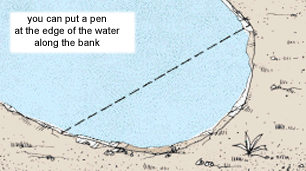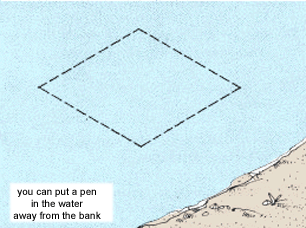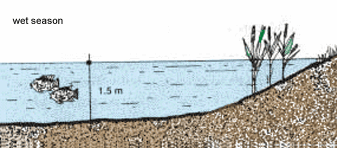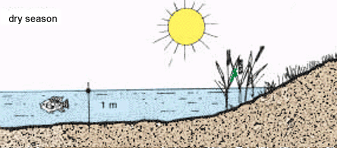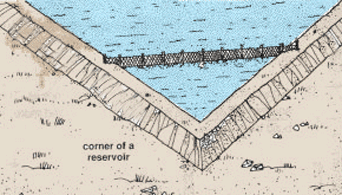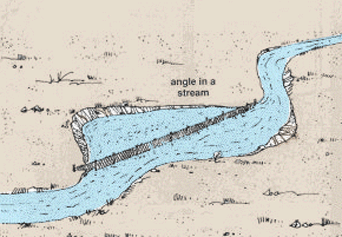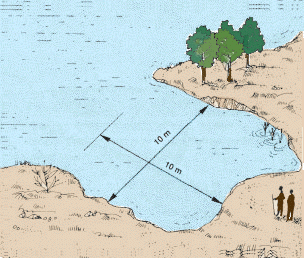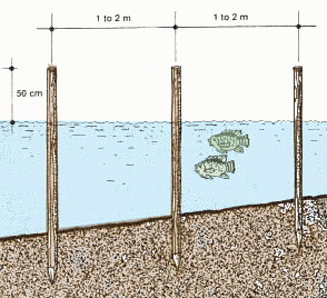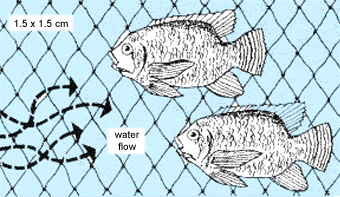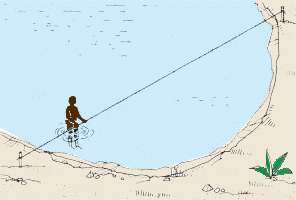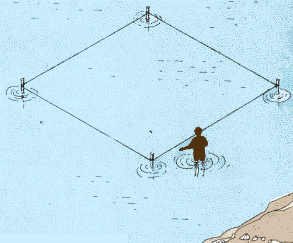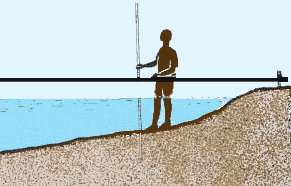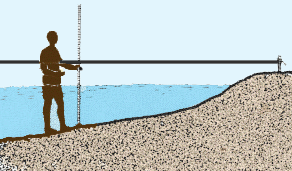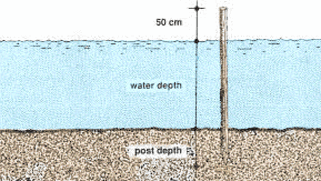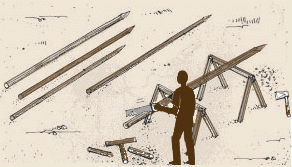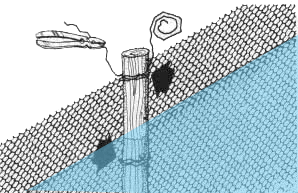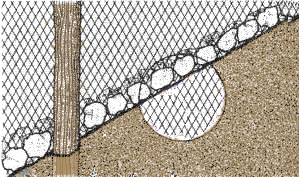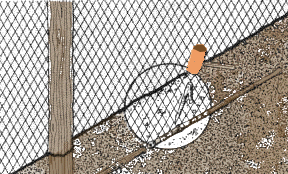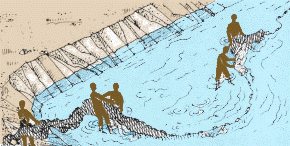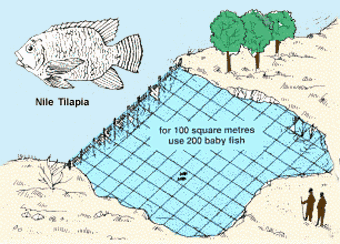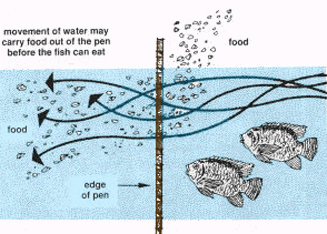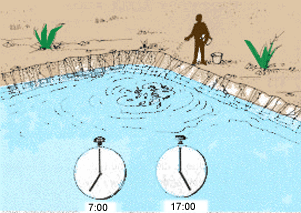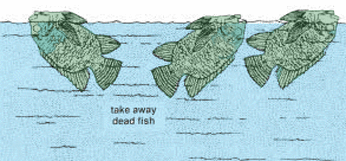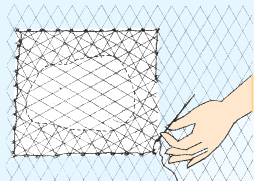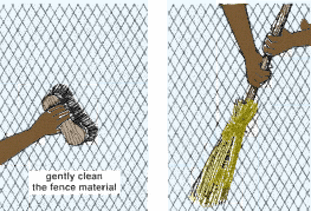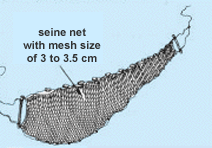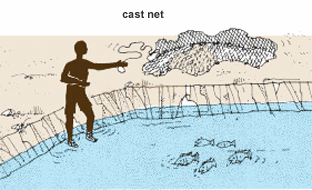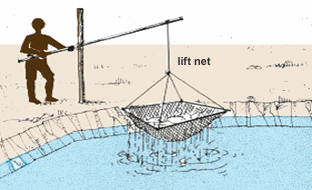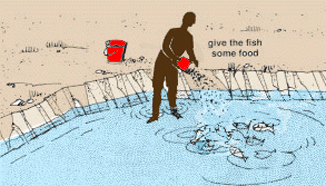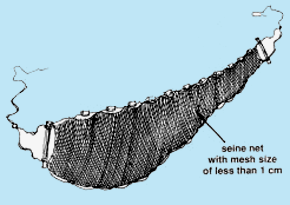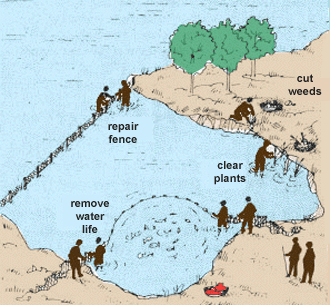15. PRODUCING FISH IN PENS
LOCATING FISH PENS(368) You can build a pen in the shallow water of a stream, a river, a lake or a reservoir.
|
|
|
|
(369) The water in a pen should be no more than 1.5 metres in the deepest part. |
|
|
|
|
(370) You must also be sure that the water in a pen will never be less than 1 metre even during the dry season. (371) A pen should be put in a place where the flow of water is gentle, not fast. |
(372) It should be protected from wind so that the surface of the water will be calm, not rough. (373) Choose a place in the stream or lake where the bottom is firm. It is not easy to build a pen if the bottom is too soft, and where the water may become muddy when you have to work in the pen. |
|
|
(374) Try to find a place where you can build a pen using very few materials, such as the corner of a reservoir or an angle in a stream.
|
|
HOW LARGE SHOULD YOUR PEN BE?(375) A pen can be small or large depending on how many fish you want to raise. (376) However, when you first begin, start by building a small pen. You will need fewer materials, and it will be easier to take care of. (377) A good size pen to begin with is 10 by 10 metres. This is 100 square metres. Later, when you have learned more, you can build bigger ones.
|
|
BUILDING A PEN(378) A pen is closed by a fence. You start to build this by driving in a row of posts. Posts can be made of either bamboo or wood. (379) If you are using wood, choose wood that does not rot quickly when it is in the water. |
(380) The openings in the material that you use to fence in a pen must be small enough to keep the smaller fish from getting out. (381) Be sure to use material with openings of
1 .5 by 1.5 centimetres. This is the right size to keep in the
smaller fish and also to let fresh water flow through.
|
|
(382) Mark the place where you will put the fence using wooden
stakes or poles and a piece of heavy line.
|
|
|
(383) Check the bottom along the line with a long pole to see how far you will have to drive in the posts so that they will stand firmly.
|
(384) Measure the depth of the water every 2 metres along the
line.
|
|
|
(385) All posts must reach at least 50 centimetres above the highest water level. So the length of each post must equal the depth of the water, plus the depth that each post must be driven into the bottom, plus 50 centimetres for the segment above the water.
|
(386) Now you can cut all the posts to the proper length.
|
|
|
(387) If you use woven material made from split bamboo, for example, or plastic mesh, drive in the posts 1 metre apart. (388) If you use a fishing net drive in the posts 2 metres apart. |
(389) If you use fishing net for the fence tie the edge-line of the net to the top of the posts using strong cord. |
|
|
|
|
| (390) If you use woven material for the fence, tie
it to the posts with strong cord. You can also use strong vines
instead.
|
(391) If you use plastic mesh for the
fence, fasten it to the post with wire.
|
|
(392) When the fence material is well fastened to the posts, you are ready to bury the material in the pen bottom. (393) You can bury fence material by pushing it into the pen bottom and putting a row of stones on either side to keep it in place.
|
(394) You can also bury fence material by fastening it to straight
poles and pushing the poles into the pen bottom with wooden stakes
to keep it in place.
|
|
(395) When your pen is finished, cut the weeds and grass on the banks, clean out most of the plants in the water and take away any rubbish that you find. (396) Then remove the unwanted fish, crabs or other water life in the pen. You can do this using a fine-mesh net. (397) Now you are ready to stock your pen with baby fish. |
|
PUTTING BABY FISH INTO YOUR PEN(398) If you are raising Nile tilapia you will need to put in two baby fish for each square metre of pen. So, if you have built a small pen of 100 square metres you will need 200 baby fish.
|
(399) The baby fish that you use should be at least 8 to 10 centimetres long or weigh about 15 to 20 grams each. Note: If you need any help or want to raise a different kind of fish, your extension agent or fishery officer will be able to give you good advice. (400) Just before you put the baby fish in your pen, be sure that the water they are in is not hotter or colder than the water in the pen. (401) If the water the fish are in is hotter or colder, slowly add water from the pen to the water with the fish until it reaches the same temperature. |
FEEDING FISH IN PENS(402) As you know, with a pond you fertilize the water. You add compost, animal manure or plant materials so that there will be natural food for the fish to eat. (403) In addition, fish in ponds must be given other kinds of food each day to make them grow quickly. (404) With well-fertilized water and enough additional food, the fish can swim about and find food anywhere in the pond.
|
(405) However, with a pen built in a stream, lake or reservoir, there may be little natural food and the movement of water may carry the food that you give the fish outside the pen where the fish cannot get it.
|
|
(406) Be sure to feed your fish well. You may use cottonseed or groundnut cakes, wheat or rice bran, mill sweepings or beer wastes. (407) Follow the recommendations given for ponds (see items 284 to 297):
|
|
TAKING CARE OF YOUR FISH IN A PEN(408) You must always watch your fish to see that they are healthy and swimming strongly. (409) If the fish in your pen are not well, they will stop eating. |
(410) If this happens, stop feeding your fish for a day or two. (411) When you begin to feed them again, at first give them small amounts of food and then slowly more and more. When your fish begin to eat as before you will know that they are well again. |
|
|
(412) If you find any dead fish floating in the pen, take them out right away. (413) Then stop feeding your fish and watch them very carefully during the next days. (414) If no more fish die you can begin to feed them after a day or two. (415) If fish continue to die take them out as soon as you can and ask your extension agent or fishery officer for help. |
|
TAKING CARE OF YOUR FISH PEN(416) A pen can be easily damaged. If this happens your fish may get out. (417) Check the pen fence every day to be sure that there are no holes. At the same time, you should check that the fence is well buried in the pen bottom. (418) If you find any places where your fish can get out, repair them right away. |
|
|
(419) In addition, you must be sure that the openings in the fence are free of dirt and plants so that fresh water can flow into the pen. (420) You can clean the fence of a pen using a brush or a broom. However, do it very gently so that you do not damage the fence material. |
|
HARVESTING FISH IN PENS(421) If you have used baby fish 8 to 10 centimetres long and have fed them well, they will be ready for harvesting in about six to seven months. At this time the fish will weigh 100 to 150 grams each. (422) If you want to harvest only some of your fish you can use a seine net with a large mesh. (423) A seine net with a mesh size of 3 to 3.5 centimetres will catch only the biggest fish and allow the medium and smaller fish to escape. |
|
|
(424) To harvest with a seine net you will need several people. Start at the deep end of the pen and pull the seine net slowly toward the shallow end. The drawing shows you how. |
|
|
(425) If you want to harvest only part of your fish, you can also use a cast net or a lift net.
|
|
|
(426) If you use a cast net or lift net you will catch both big and small .fish. Keep the fish that you want and put the others back in the pen. (427) With a cast net or a lift net it is easier to catch the fish while they are eating and they are all together. So, feed them some food first.
|
|
|
|
(428) If you want to harvest all of the fish you can use a seine net with a fine mesh of less than 1 centimetre. Note: If you do not need all of the fish, harvest only what you need and leave the rest in the pen. Fish can be left in a pen as long as you continue to feed them. |
|
STARTING AGAIN(429) After you have harvested, clean and repair your pen as quickly as you can so that you can begin again. You must
|
CLEANING AND REPAIRING YOUR PEN |
|
|
(430) If you have harvested using a large-mesh seine net there will be many baby fish left in your pen. (431) In this case to begin again you will not need to put in more baby fish. However, you will have to be careful not to let the baby fish escape when you clean and repair the pen. (432) If you have harvested using a fine-mesh seine net you will have caught most of the baby fish. (433) You can hold the baby fish that you caught in a smaller pond or in a cage for small fish until you have finished cleaning and repairing the pen. |
Note: The faster you can do all of these things, the sooner you will be able to raise another crop of fish. (434) When you are ready, put in two baby fish 8 to 10 centimetres long for each square metre of pen. However, be sure to choose your biggest and best baby fish to put back into your pen. |
|
|
|
Summary
YOU HAVE LEARNED HOW TO PRODUCE FISH IN PENS
To locate your fish pens best, look for
- good quality water in a stream, river, lake or reservoir
- shallow water, from 1.5 to 1 m deep
- gentle water flow
- protection from strong winds
- a firm bottom
- an area where you can build the shortest fence possible
To begin, prefer a small pen such as 10 x 10 m
Build your pen with cheap, locally available materials:
- drive a row of posts into the bottom, at 1 to 2 m intervals
- keep their heads 50 cm above the highest water level
- secure fencing material to the posts
- use woven material or netting with 1.5 cm openings
- bury its lower edge well into the bottom sediments
- fix it there with wooden clamps or stones
Prepare your pen properly:
- remove aquatic plants and debris
- fish out wild fish as much as possible
Obtain baby fish and put them in your pen:
- if you use tilapias, you will need two baby fish per square metre
- prefer strong baby fish, 8 to 10 cm long, 15 to 20 g each
Feed your fish well with local by-products and wastes:
- feed once a day at about the same time and place
- regularly check for left-overs and adjust the food ration accordingly
Harvest the fish after 6 to 7 months:
- you can use a seine net, a cast net or a lift net
- to harvest only part of the big fish, use large-mesh nets
- to harvest all the fish, use a small-mesh seine repeatedly
Keep the baby fish alive as you have learned earlier
Prepare your pen for another production season
Select the strongest baby fish and begin again
